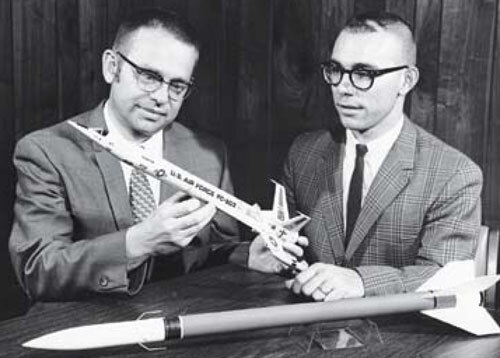
Model rocketry pioneers Vernon Estes and Bill Simon. (via VernEstes.com)
The cross-section of strangers that realized they were made for each other
What happens when a couple of shoe sellers meet a science and technology writer? Well, they obviously create a new industry.
The writer in question was G. Harry Stine, whose work at Popular Mechanics among others was widely circulated in the 1950s. Stine and his wife were close with famed sci-fi writer, Robert Heinlein, who dedicated many of his novels to the couple. One of his articles caught the attention of brothers Robert and Carlisle Orville, who had developed a safe model rocket motor for Robert to use in lectures about amateur rocket-powered aircraft.
In addition to being a science writer, Stine worked primarily as the safety range officer at the White Sands Proving Grounds, where America tested and developed the rockets that would later be used for nuclear weapons and the space race. Russia would, of course, beat the U.S. to orbit with the launch of Sputnik in 1957. The resulting explosion of interest in model rocketry led to many curious kids taking up their own attempts at rocket production.
In his 1957 article, “The World’s Safest Business”, Stine wrote, “In the 11 yeats of White Sands history, we have fired over 10,000 rockets and lost only two men-men who would still be with us if the rules had been followed.” Stine offered this admonition because growing amateur interest presented a problem to officials. “When we get letters from amateur rocket men-most of them asking for detailed, specific information-we usually give three loud cheers and shake in our boots at the same time … we shake in our boots because we know rocket flight testing is dangerous.”
The article goes on to list a series of commandments for amateurs to attempt their own model rockets safely. Still, the handling of propellants is dangerous no matter how you do it and when done in mass by an amateur population, mistakes happened and people were hurt.
After reading Stine’s work, the Orville brothers realized they had coincidentally made a safe and efficient rocket motor that would greatly reduce the danger. When they contacted Stine, the brothers sent the writer/rocketeer a few samples to test fire. The results were positive enough that Stine offered to create a company to license the motor for mass production. (It probably helped that he had recently been fired from a major aeronautics firm for offering a public reaction to the Soviet launch of Sputnik.)
A few failed attempts with inconsistent suppliers started the new company, Modern Missiles Inc., on shaky footing. However, they soon partnered with Vernon Estes, the son of a fireworks manufacturer to help maintain quality. Estes delivered by designing Mable in 1958.
By 1961, the company had grown so much that they moved from their original location in Denver to a 77-acre tract just outside Penrose, Colorado which soon became known as the “Model Rocket Capital of the World”. (Some of the Orville brothers’ original designs, known as the “Rock-A-Chute Mark I and Mark II” have been preserved in the National Air and Space Museum.)
A scene from the 1999 film October Sky, the story of rocketry enthusiast Homer H. Hickam, Jr., who went on to become a NASA engineer.
Interest in model rocketry has waxed and waned over the years, like many hobbies. Not every kid that had their own personal October Sky went on to work for NASA. Still, it gave enough of them a latent passion for space, or at least things that went BOOM!
But as emphasis for STEM education and activities increase, model rockets are an amazing vehicle for complicated concepts. Adding a healthy dose of competition doesn’t hurt either.